Essential Tips for Winterizing Windows and Keeping Your Home Cozy
Prepare your home for winter with essential tips for window insulation and energy efficiency. Read on to keep your space warm and cozy all season long.
Prepare your home for winter with essential tips for window insulation and energy efficiency. Read on to keep your space warm and cozy all season long.
Choosing the right window company is important, so how do you know you are getting quality windows at a good value that are installed correctly? You need to do your research.
Windows play a crucial role in your home’s comfort, energy efficiency, and overall appearance. Over time, even the best windows can wear out or become damaged, leading to a range of issues that affect your daily life. But how do you know when it’s time to replace your windows? Here are some clear signs your windows may need replacing, along with tips on what to look for and why it matters.
If you notice soft, crumbling, or discolored wood around your window frames, it’s a sign of rot. Rotting wood can compromise the structural integrity of your windows and allow moisture and pests inside. The wood around your window—including the trim, sill, frame, and sash—should feel dry and strong to the touch. Rotted wood feels soft and spongy, and usually looks discolored. You may also see mold or flaking paint. Touching the wood is important, because paint, especially dark paint, can hide the discoloration that rot causes.
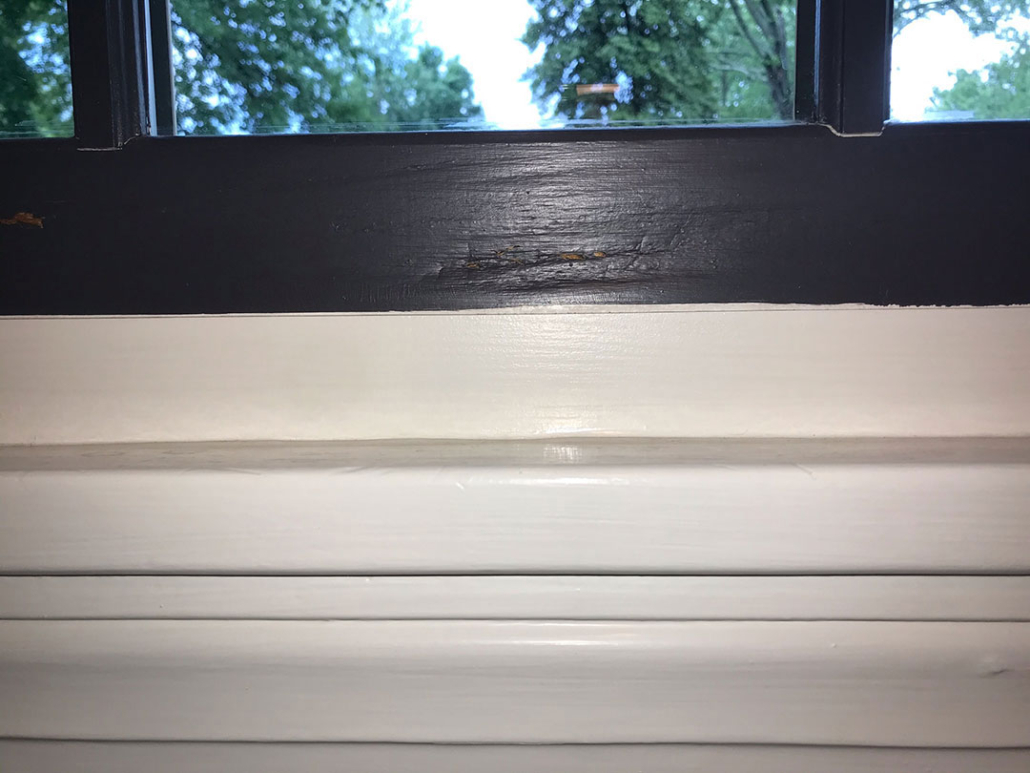
Dark paint can hide wood rot around a window.
Check regularly for rot: it’s possible to repair small patches, but large patches of rot suggest that it’s time to replace your window, sooner rather than later.
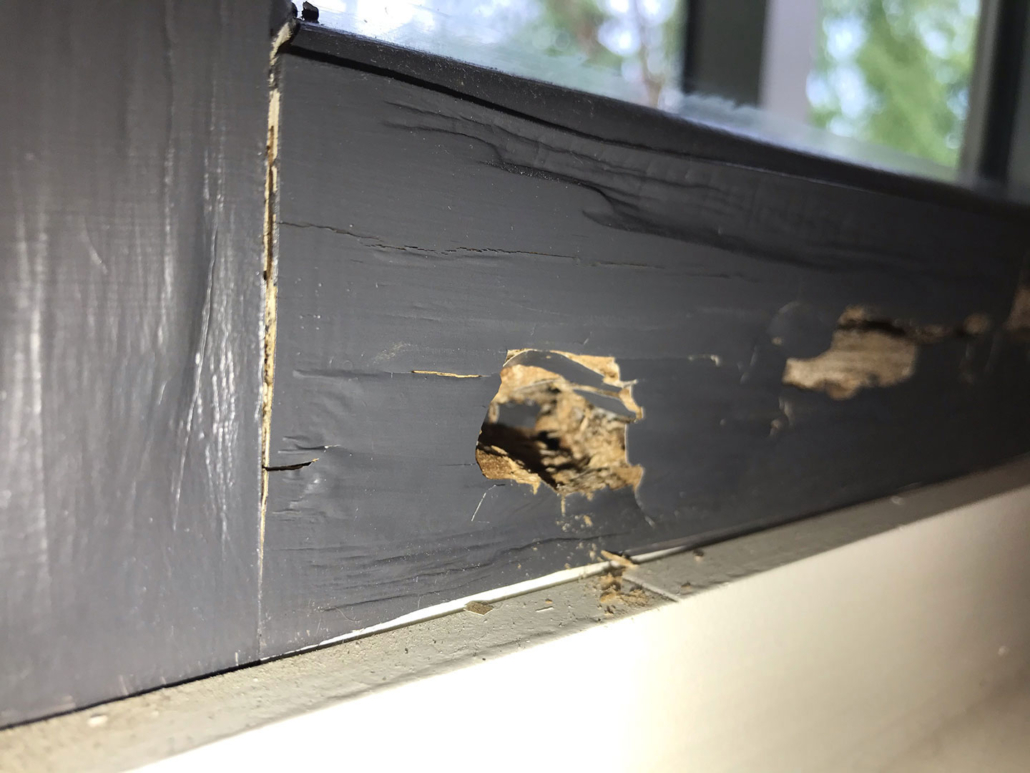
This paint was hiding disintegrating frame materials.
Today’s energy-efficient windows are made with double or triple-paned glass, also known as insulated glass. The panes of glass are joined using spacer bars and sealant around the perimeter, creating the insulating quality.
When an insulated window’s seal fails, your window may look foggy or dirty. Often customers tell us they can’t get their windows clean. This is condensation that has accumulated and dried between the glass panes. You may also see water droplets between the panes.
Finding condensation in-between your windowpanes indicates a faulty seal. Once the seal is broken, the double-paned glass loses its insulating quality. If you find seal failure in your home, it’s time to contact a professional, as your window will likely need repair or replacement.
Why it matters: Failed seals mean your windows are no longer energy efficient, leading to higher heating and cooling costs. Moisture trapped inside can also encourage mold growth.
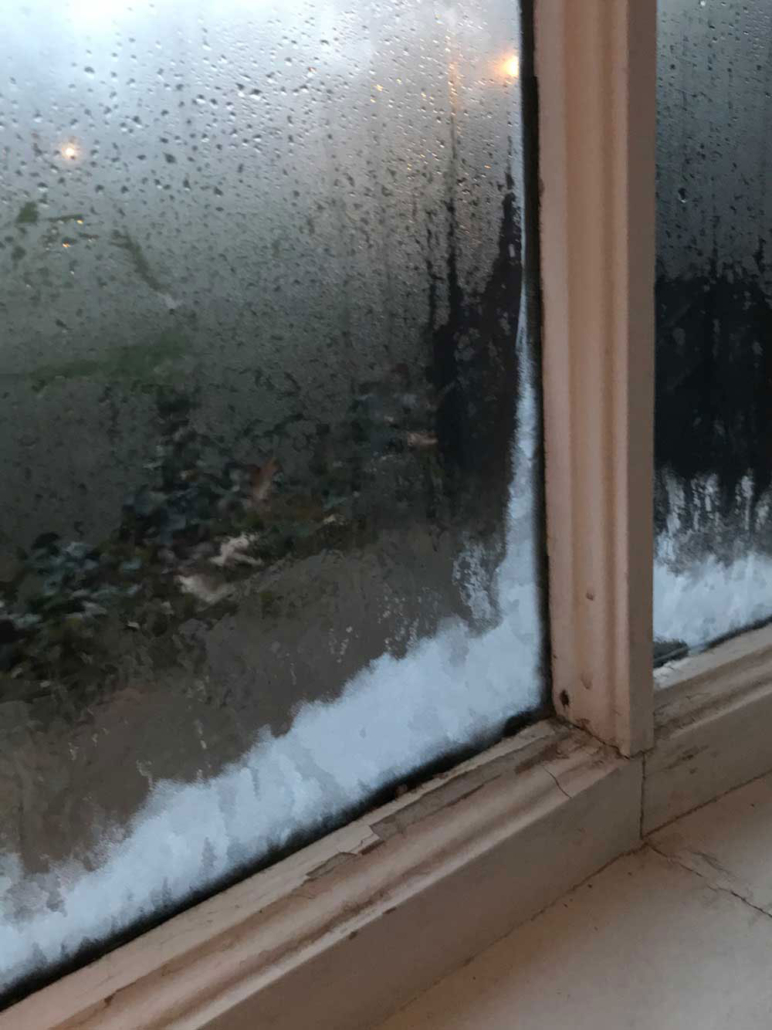
Condensation can show up as fog, Water, or even ice.
Do you feel a breeze even when your windows are closed? Drafty windows let outside air in and conditioned air out, making your HVAC system work harder and increasing your energy bills. Try the candle test: on a breezy day, hold a candle in front of your closed window. If the candle’s flame flickers, it may be time to replace your window.
Why it matters: Drafts can make rooms uncomfortable, create cold spots, and increase energy costs.
Windows that won’t lock are not energy efficient and contribute to higher energy costs. When your windows are closed and locked into place, they are sealed and in their most energy efficient state.
More importantly, windows that won’t lock properly are a security risk. If your window locks are broken or the window doesn’t align correctly, your home is more vulnerable to intruders. Secure windows are essential for your peace of mind. If you’re struggling to lock a window, it’s a sign it may need a replacement.
Why it matters: Faulty locks can let in drafts and moisture. Properly locking windows can also protect your home from break-ins and help keep children and pets safe.
Windows should open and close smoothly with little effort. If your windows stick, jam, or refuse to budge, it could be due to warped frames, swelling from moisture, or hardware failure. The windows also may have been painted shut, often multiple times over the years. Windows that don’t operate properly can be frustrating and even dangerous in an emergency, such as a fire when you need a quick exit. If you are experiencing issues with your windows function, you should have a window professional do an inspection.
Why it matters: Windows that don’t open or close properly can trap you in an emergency, reduce ventilation, and make cleaning difficult. They may also indicate, even without visible damage, that you have deeper structural issues.
Cracks in window glass are more than just an eyesore—they’re a safety hazard. Broken glass can shatter further, putting your family at risk of injury. Even small cracks can let in drafts and moisture, so it’s best to address them promptly by repairing the glass or replacing the window. With modern windows once a pane is cracked the insulated glass seal is broken as is the energy effectiveness of the window. This requires window replacement.
Why it matters: Cracked glass reduces your home’s security and energy efficiency. It can also allow water to enter, leading to rot and mold. Once a double pane window’s glass is broken it is no longer energy efficient.
If your home still has single-pane windows, you’re missing out on the benefits of modern, energy-efficient options. Single-pane glass does a poor job of insulating your home, leading to higher energy bills and less comfort. Upgrading to double- or triple-pane windows can make a noticeable difference in both comfort and cost savings. New, high quality windows are ENERGY STAR rated and offer UV protection
Why it matters: Single pane glass plays an important role in poor energy efficiency. Modern windows and doors offer better insulation, noise reduction, and UV protection, helping to preserve your furniture and flooring.
Water stains, bubbling paint, or damaged drywall near your windows are signs of leaks. Moisture intrusion can lead to mold and mildew growth and further damage to your home’s structure. If you spot these issues, your windows may no longer be keeping water out as they should.
While these aren’t signs it’s time to order replacement windows immediately, they are signs it is time you may want to have your old windows inspected by a professional. And they could be signs of failing windows.
Do you hear a lot of noise from outside, even when your windows are closed? Older or poorly insulated windows can let in unwanted sounds from traffic, neighbors, or the environment. Newer windows with better insulation and improved energy efficiency can help create a quieter, more peaceful home.
Why it matters: Excessive noise can disrupt sleep, concentration, and relaxation. Upgrading your windows can significantly improve your quality of life.
Sometimes the type of window in a room isn’t consistent with how the room is used.
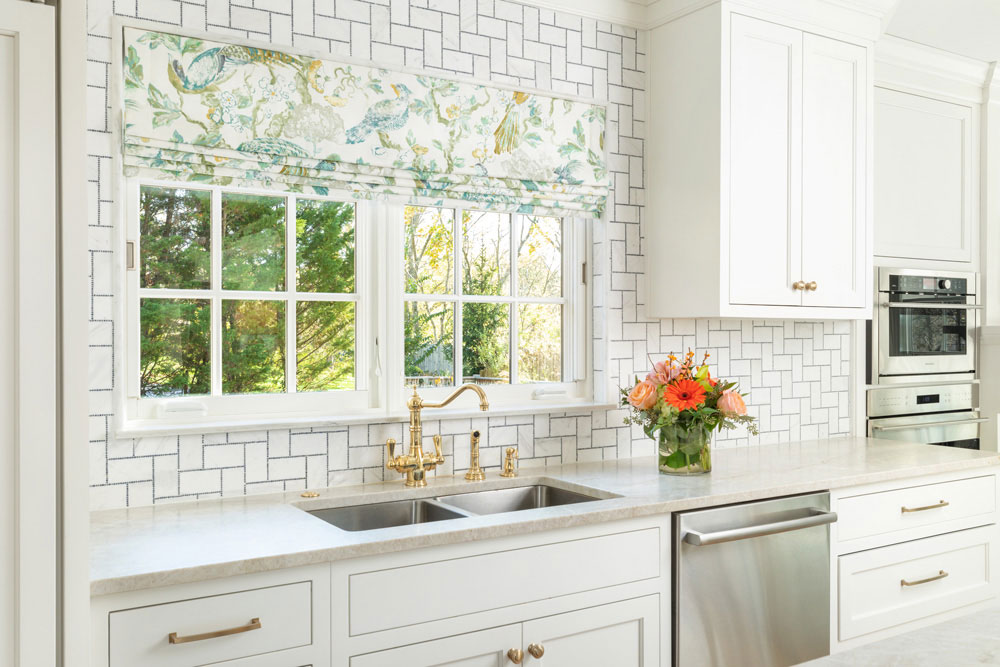
These are casement windows, much easier to open over a sink than double hung.
For example:
Why It Matters: Replacing windows to improve airflow, views, or curb appeal can increase comfort and aesthetics. With so many new options, you can be sure there is a window type with the functionality your space needs.
Sometimes you move into a house that has great bones, but there are some details you want to change. If you have an older home with windows that have already been replaced with something that clearly doesn’t match your home’s architectural style, you should look for replacement windows that complement your home’s design.
Why It Matters: If you don’t like your current windows, you can and should change them. Design experts can help you choose replacement windows that will match the style of your home and your personal taste.
Your home’s windows play a significant part in its energy efficiency, if you’ve noticed your heating and cooling costs creeping up, your windows may be to blame. Poor insulation, drafts, and failed seals all contribute to energy loss. Compare your recent utility bills to those from previous years—if there’s a noticeable increase, it may be time for that window replacement project.
Why It Matters: Modern, high-quality, duel pane windows come with low e glass that minimizes heat gain. When installed properly, the entire window will have a tighter seal, and better insulation leading to energy savings.
If you notice any of these signs it’s time to replace, the experts at Door Store and Windows can answer your questions and offer consultations and free estimates. Click here or call, 502-503-4718. At Door Store and Windows, our goal is to provide peace of mind and customer satisfaction throughout the entire replacement process. Click here to learn more about the replacement process from consultation to install. If you have any questions, feel free to give us a call at (502) 503-4718.
Read about out our door replacement process by clicking here!
Your home is an expression of your personal style, and the front exterior is the first view guests will have as they pull up to the curb. What impression are you looking to make? Dramatic? Traditional? Vintage? Sophisticated?

Traditional Entry Door with Black Sidelites
Regardless of the look you’re going for, choosing black windows instead of light can help make that design statement. While black windows are experiencing a resurgence in popularity right now, their history stretches back centuries. In medieval Europe, black iron window frames were one of the only available materials.

Black Window Interior
Today, black windows seem to be showing up more frequently on design shows, in magazines and online. But are dark exterior windows just a trend? And if not, how can they work in your home?

Black Windows on A Frame House
We asked Ann Gregory at the Door Store and Windows for her thoughts. “I personally believe all colors are a trend,” she told us. “Just consider your own interior and exterior color palette. It’s very common to change color often. When it comes to dark windows, though, bronze and black are very classic colors that will never go out of style.”
Whenever you contrast a dark color with a lighter one—like black frames against white trim—it creates an immediate, dramatic effect. It might surprise you just how much the window frame color can impact the appearance of your entire home. Painting a house white with black windows is a timeless, high-contrast look that can really pop.

2 story floor to ceiling black windows
Unlike white windows, black windows are designed to be seen, not covered. Just like a picture frame enhances art, dark frames draw your eye to the view beyond, creating a composition of light and dark, during the day and into the night. Some homeowners even forgo window treatments like blinds to preserve this effect.
Looking for a softer take? Gregory suggests, “You can balance the look with dark sashes and lighter frames—mixing bold and subtle elements.”

Black French Doors with Black Windows
Black windows work across design styles—whether you’re going for a farmhouse, industrial, craftsman, or traditional aesthetic. They add crisp lines and architectural detail that helps them blend into nearly any design vision and stand the test of time.

Black Window Traditional Home
Black windows work across design styles—whether you’re going for a farmhouse, industrial, craftsman, or traditional aesthetic. They add crisp lines and architectural detail that helps them blend into nearly any design vision and stand the test of time.
Now that we have told you the great things about dark windows there are a few things to think about before you make your purchase. Black windows may fade more quickly than lighter windows and they may need more frequent cleaning. But don’t lose hope, these issues can be minimized!

Dark Framed French Doors
Unlike white windows that do not fade as they age, exterior dark windows will inevitably show their age. It is important to invest in windows with higher quality components and a longer life span. Windows made from extruded aluminum cladding (versus thinner roll-form aluminum) retain their dark finishes longer. They may have a larger upfront cost but benefit from better protection against fading.
Two other things to think about when considering fading are the elevation and directions your window face. Exterior windows facing west or south fade more quickly than those facing east and north due to the sun’s direct UV rays. Also, windows in full sunlight will fade faster than those in shade. When it comes to elevation, higher windows are often exposed to more sunlight, unless they have a shade element nearby. More direct light means more susceptibility to fading.
Although they look sleek, black or dark windows can show dust, fingerprints, and water spots more easily than lighter options. This means you’ll likely need to clean them more often, especially on the interior, where frames are more visible. You can visit our blog to learn about 10 Simple Window Cleaning Tips.

Grey Marvin Windows and French Doors
In general, dark windows do not cost more than white windows. Virtually all types of windows can be purchased in dark colors. Still, you want to make sure your investment will last. That’s where warranties come into play. The better the construction of a window, the longer the warranty. Windows made from extruded aluminum can have warranties of up to 30 years. It’s also important to note that some manufacturers only cover manufacturing defects, which doesn’t include fading, so carefully vetting the warranty is critical. As they say, you often get what you pay for and peace of mind in knowing your investment is protected can be well worth the added cost.

Black Windows with Black Transom
Still undecided? You don’t have to go all in. You can test the look by installing black windows in just one room or area—like your office, bathroom, or back doors—before committing across your entire home.

Black door with Black Transom
Remember: whatever you choose, new windows can refresh your home’s façade and add curb appeal. Just be mindful of how the frames will look against your siding, exterior color, and other design elements.
And don’t forget the bigger picture. A window’s color isn’t just about today—it’s about how it’ll work with the rest of your house over time.
No matter what color you choose, any upgrade to your windows is a valuable asset to your home. That’s why working with a window specialist—rather than someone who does roofing or siding for example—is always a good idea. If you’d like advice about investing in your home’s curb appeal, the experts at Door Store and Windows can help you find the design solution that’s right for you.
Severe weather has hit the Louisville area and hail may have damaged your windows and doors. What do you do?

If you’ve ever shopped for new doors, you know there’s a lot more to them than just door hinges and door panels. Doors have a long list of parts and pieces the average homeowner may not be familiar with. Below you’ll find a brief introduction to some of the most common parts of a door that will help you better understand your purchasing options and hopefully lead to a more informed decision about which new door is right for your project!
The door structure is the support system of the door that allows it to function.
Made up of side jambs, head jambs, and mulls, the door frame provides the structure to the door opening. It’s the surrounding part of the door opening that the door panel fits into.
Sometimes called a slab, the door panel is the whole part of the door that swings back and forth. A door panel can be made of a single piece or multiple pieces. Many doors are divided into several smaller panels of wood or glass.
The rails are the horizontal segments along the top, bottom and sometimes middle of the door, depending on the panel configuration. Rails provide stability for the door and help hold the panels in place.
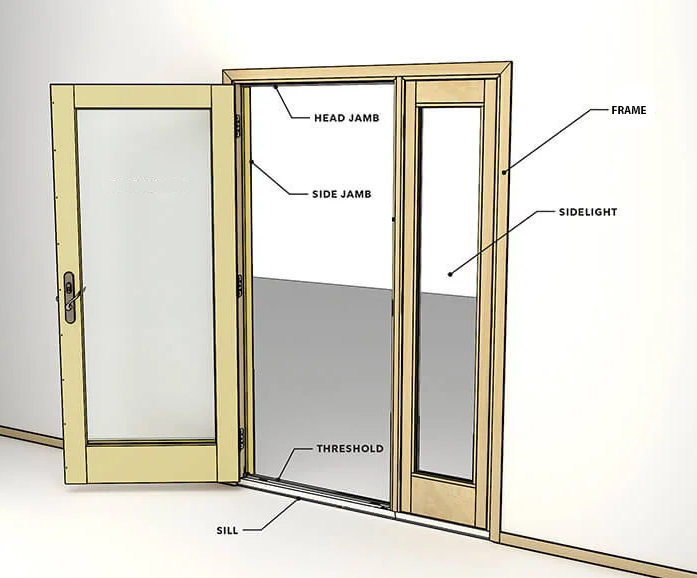
The narrow, vertical components on either side of a door panel are called the stiles. The lock stile is on the side with the door knob or handle, while the hinge stile is on the side with the hinges. Stiles provide stability and structural support for the door panels.
The casing is essential for door replacement, as it is the interior trim that surrounds the door and covers the gap between the door and the drywall. It also serves as a decorative element to hide the door frame, insulation and caulking.
The vinyl, fiberglass or aluminum jacket that covers the wooden core on the exterior side of a door is called the cladding. Usually used on exterior entry doors, it helps preserve the wood and improve its weather resistance. Cladding can also improve insulation and sound proofing.
A door jamb is the vertical component of the door frame, located on either side of the door. The head jamb is the horizontal piece at the top of the door frame, spanning the width of the door and connecting the two vertical jambs. The door jamb and head jamb work together to provide support and stability to the door.
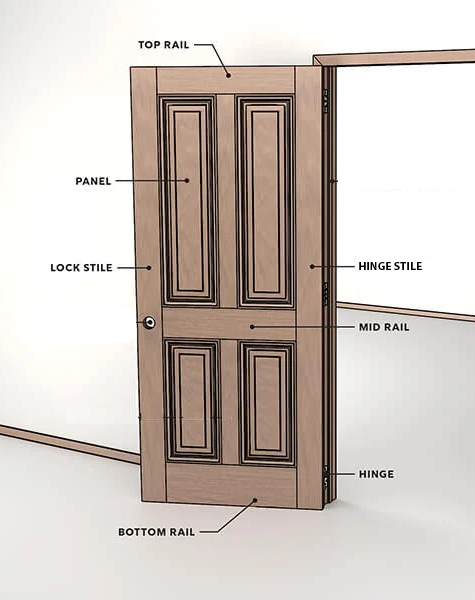
Door hardware includes locking systems and hinges. The hardware provides security and can be a stylish design element.
These are the pieces of hardware that allow the door to swing open and closed. Standard-sized doors typically have three hinges while larger, heavier doors may have four or more to help bear the load. Hinges can be in-swing or out-swing. Standard exterior doors are typically in-swing but if the door leads to a small interior area, out-swing may be a better option.
This thick metal plate is attached to the door jamb and has a hole to accommodate the door bolt (or multiple holes for multiple bolts). The strike plate guides the bolt into the jamb and is essential for security. It reinforces the door jamb and helps prevent forced entry.
The lockset is the complete door lock system including the lock mechanism, knobs, keys, plates, strikes, door latch, key cylinder, and other components that allow the door to lock in place and better prevent forced entry.
This is a locking system where the hardware locks at different places in the door but can still be controlled by a single lock mechanism. It allows for added security and ease of use.
This section covers the door parts that help fill the gaps between the door and frame.
The bottom, floor-fastened component of an exterior door frame is called the sill, which helps to seal the entry from leaks and other intrusions.
Creating a weather-resistant barrier between the bottom of door panel and the sill, the sweep is made of rubber, foam, neoprene or vinyl.
The threshold is the strip of metal, wood or fiberglass that covers the sill on an exterior entryway, providing an added seal against things like weather, drafts, and pests.
These tall, narrow windows are found on one or both sides of the door, allowing more light into the entry way and improving the view.
Divided lights can also be called Grids, Grilles or Muntins. Divided lites create the look of multiple, individual panes of glass in a door. They can use many different panes of glass or can be simulated to mimic the look of multiple panes to take advantage of the improved energy efficiency of a single pane. Divided lites are popular in a wide range of architectural styles, from historic replications to modern farmhouses.
This glass panel assembly consists of two or more sealed glass panes separated by a space between to reduce heat transfer. Insulating glass, which can contain argon for improved thermal insulation, is one of the most impactful window and door features in terms of energy efficiency.
Often used on entry doors and bathroom windows, obscured glass features a pattern in the pane that provides privacy while maintaining some visibility, as well as allows in some natural light.
This safety glass is required for doors with large glass elements. The glass is heated and then cooled rapidly in a controlled environment for added strength. The tempering process also makes the glass safer due to the pebble-like fragments created when shattered.
These windows are located above a door and can be either stationary or operating. They allow more natural light to enter while also adding a decorative touch. Transom windows come in a variety of sizes and shapes and some open for better venting. You can opt for double paned glass or decorative glass.

Door Store and Windows offers a wide variety of doors with an almost endless selection of options to incorporate into your home, no matter your style or need. We also love to talk doors! Our consultants would be happy to meet with you to help you decide what type of door functions and looks best in your home.
Of course, if you have any other questions about entry doors, interior doors, storm doors, or whatever kind of door you need for your next project, CONTACT US today. You can also learn even more about doors, parts of a door, or other door-related goodness our Doors 101 video

You’ve invested a lot in your windows, so it’s only natural to want to keep them clean and looking their best! The traditional method of using glass cleaner and newspaper or paper towels to clean your dirty windows is no longer considered the best method. It’s time to embrace more effective cleaning techniques. Keeping your windows clean not only enhances the look of your home but improves visibility and natural light. A thorough cleaning routine can also boost curb appeal while extending the lifespan of your windows by preventing the buildup of dirt, grime, and hard water stains.
So without further ado, here are some professional cleaning tips to help you achieve spotless, clean windows.
That bright blue window cleaner in your cupboard is indeed one of the oldest cleaners on the market, but it’s also one of the worst things to put on your windows. Why? Because it leaves behind a waxy, streaky, and hard-to-remove film. Each time you use run-of-the-mill glass cleaner on your windows, that film builds up and spreads the dirt and dust, making your view hazier with each use.
You should also stay away from harsh chemicals like ammonia, which can be dangerous to work with. Instead, clean your windows with a solution of warm water and gentle dish soap (like Dawn). About one bucket of warm water and an ounce of dish soap will create a cleaning solution far more effective – and far more affordable – than the pre-packaged alternatives.
To achieve streak-free, clean windows you’ll need to use the right cleaning tools. Instead of using paper towels, which often leave lint and debris, try a microfiber cloth. A two-bucket cleaning system is also essential to prevent the reapplication of dirty water. One bucket will hold cleaning solution, and a second bucket will hold plain water. You should also consider buying a high-quality squeegee for better water removal and to prevent hard to remove streaks.

Using the right tools will help you get a streak-free finish.
Before you begin cleaning, it’s always best to do some prep work for best results. You can start by cleaning dirt, dust and other debris from the frames and sills with a vacuum or soft cleaning brush. If your window tracks are dirty, they’ll accumulate grime faster, so cleaning them thoroughly is crucial. You should use warm, soapy water to wipe down your window frames and tackle stubborn stains. For smudges or marks, use a non-abrasive cleaner.
A trick we like to recommend for deep cleaning window tracks is to use a soft bristle vacuum cleaner attachment. Vacuuming can remove large debris. Follow up with a damp soft cloth to remove finer dirt.
When cleaning the glass, technique is everything! Dip the microfiber cloth into your bucket of window cleaning solution, wash your windows in a zig-zag motion to help prevent streaks, and then rinse the cloth in a second bucket of plain water. When cleaning big windows, use a squeegee for a cleaner finish. You should try to clean your windows starting from top to bottom to avoid dripping water and cleaning solution onto areas you’ve already cleaned.
Just like the glass in your windows, your window screens also need regular maintenance to keep them dirt- and dust-free. A great way to remove loose debris and dust is to use a vacuum cleaner with an upholstery brush attachment. For tougher grime, you can gently scrub the clean window screens with a sponge, warm water, and a mild detergent. But be careful to only use light pressure; window screens are delicate and may bend easily.
We also suggest removing the screens completely from the frame so you can wet them down outside. Lay them flat and scrub both sides using a soft brush before rinsing. Make sure to let the clean window screens dry completely before reinstalling so that you don’t risk any buildup of mold and mildew.

Use a microfiber cloth to avoid damaging the finish of your windows.
When it comes to more stubborn stains and dirt, you should consider using a few drops of dish soap directly on the dirty area, then gently scrubbing it with a microfiber cloth. A brush with harder bristles might also help with tougher spots on window frames, though you shouldn’t use brushes that are so firm they can scratch the finish. As mentioned above, harsh chemicals and abrasive cleaners can also cause damage, so it’s best to avoid them.
Though cleaning gets top billing, drying your windows can be just as important to avoiding water spots and streaks. When you’re finished with your washing regimen, grab a dry microfiber cloth and a squeegee to wipe away any remaining residue and to remove excess water. Chamois cloths are another great tool for drying, as they are very absorbent and lint-free. And don’t forget to dry your clean windows in direct sunlight, if possible, for a spot- and streak-free finish.
Once you’re done with washing and drying, you should always carefully inspect your work so you can spot-clean any streaks or stains you missed. If you didn’t already, you should also use a microfiber cloth to wipe down your window frames and ledges to remove dust and excess dirt. We recommend using a coffee filter to wipe down clean windows to help achieve a completely lint-free and streak-free finish.
Performing regular window maintenance is critical to keeping your windows in their best condition. You should make a plan to clean your windows at least twice annually – and maybe more than that if you live in an area with high levels of pollen. Cleaning your windows not only keeps them looking good, but keeps them functional and sound. It gives you a chance to inspect your windows and the surrounding frame and sill to make sure there’s no rot, separation or other issues that could lead to poor insulation or the need for window replacement.

A telescoping window cleaning tool can help with those hard to reach areas.
Now that you’re ready to clean your windows, we’d be remiss if we didn’t mention that washing windows can be dangerous! If you’re cleaning windows yourself, always have someone stabilize your ladder to mitigate your risk of a fall. Even professionals use the buddy system when working on hard to reach interior and exterior windows.
For hard to reach windows, you should think about investing in a telescoping window cleaning tool. These kinds of tools make it much easier to clean high up windows without a ladder. If you have a multi-story home, you might also consider hiring a professional window cleaner, who will safely and thoroughly clean those hard to reach spots.
Remember, it’s important to clean your windows, not only to improve how your home looks but for a healthier indoor environment with more natural light. If you follow these essential cleaning tips, it will be easier to keep your windows nice and clean year-round. A little effort goes a long way in enhancing your home’s appearance and maximizing your view!
That’s why Door Store and Windows customers get a voucher for Sunshine Window Company with the purchase of eight or more replacement windows. If you’ve been thinking about replacing your windows, there’s no better time. Contact us to get started today with a free consultation with one of our window specialists!
For more helpful tips, visit our window and door operation, care and maintenance maintenance page or check out the video below.
As the adage goes, when one door closes another opens. But what happens if your door sticks? 😉 Seriously though, issues with the doors in your home can be a headache. Here are some of the most common problems homeowners face, as well as some tips on how to remedy them.
A Sticking Door – No, we’re not talking about the grandkids getting their popsicle juice all over the doorknob. What we’re referring to is a door that doesn’t open easily. So, what exactly causes a door to stick? Typically, it’s expansion and contraction of the door slab, often caused by humidity or other environmental factors. Usually when this happens the door will eventually return to normal operation with the seasonal changes in temperature.
However, sometimes the you may need to remove the door slab and trim it on the hinge side or bottom—or sometimes both. If you trim the hinge side, the hinges will have to be re-mortised so they’ll sit flush in the new spot. If the bottom is trimmed, you’ll need to either replace the door sweep or reinstall the existing one. Needless to say this kind of intricate work—especially on an entry door—is best left done to a professional.
A Drafty Door – Can you feel air coming in around the edge of your door? This is caused by a bad seal. Weather stripping can get torn, smashed or broken over time. A warped door will also cause it not to seal. If the door is not warped, then just replacing the weather stripping might fix the issue. However, if the door is warped, additional weather stripping might be needed or you could try adjusting the hinges so the door fits more evenly within the frame.
A Sticking Lock – When your lock is sticking, it can be either the door or the lock that’s the issue. It’s possible that the strike plates in the frame are not aligned with the locks, due to the door settling or sagging. A way to resolve this issue is to move the strike plates so they are again aligned with the locks. A simpler reason a lock might stick is it needs lubrication. You can squirt a small amount of dry lubricant or graphite powder inside the slot where the key goes, insert the key, then lock and unlock the door a few times to ensure the entire locking mechanism is lubricated.
Many of us have been there—you know your home’s facade needs a refresh, but you can’t quite put your finger on exactly what to change. If you’re looking to incorporate a new color into your design palette or update aesthetics to boost curb appeal, painting your windows could be the project to consider. Phillip Patterson, president and owner of Phillip Patterson Painting, Inc., is here to offer some helpful tips and tricks to set you up for success!
Consider Your Window Material
When it comes to painting, Patterson says the first thing to consider is the material of your windows. “Wood, fiberglass, and clad can all be primed and painted with interior/exterior paint as you normally would. For vinyl, however, you’ll need to find the right bonding primer to ensure the paint has maximum coverage and durability.”
He recommends testing the bonding primer on your vinyl windows by applying it to a small area and waiting a few days (or even weeks) to see how it reacts. The last thing you want to do is rush through the job, then discover your primer isn’t up to the job—and have to start again from scratch.
One of the most important decisions you’ll make is choosing the quality of paint you use. There are lots of options available at many different price points, but Patterson recommends never going cheap.
“Top grade exterior paints last longer,” he says. “Four years or so in the sun and eight if not in direct sunlight. Cheaper paints will likely not last nearly as long. So though you might save money initially, you’ll have to repaint everything much sooner.” A bit of added cost up front will mean you’re not redoing the job in a couple of years and spending the money you may have saved on cheaper paint to buy another round of supplies and labor.
Decide What and What Not to Paint
Once you’ve got your paint, the next step is deciding where to apply it. Make sure to adequately cover the sashes, grilles and rails. “Stay detail-oriented,” Patterson says. “Get down in the tight corners. In a casement window, it can be easy to miss the top edges and around the sides. Also, be sure to get full coverage so you don’t have to start over.”
As for what not to paint, avoid the weather stripping, window tracks, and hardware. You want to paint the window itself and not the attachable materials, otherwise you may restrict the window’s movement, making it more difficult to open and close. Additionally, to avoid painting your windows shut, make sure your windows are open when you paint and keep them open until the paint is dry. “Another easy mistake to make is keeping the windows completely still after painting,” says Patterson. “As the paint dries, move the window gently now and then to avoid painting them open.”
After your windows have a fresh coat, it’s important to keep an eye on them in the coming months and years. When the paint starts to crack, they need to be repainted or you risk water damage. The water can seep into the window and begin to erode it in places that may not be visible. The water can also freeze, which puts added pressure on the frame and potentially breaking it. Paint acts as waterproofing for windows and this water resistance can protect you from more complicated problems. It’s also critical to maintain the caulking and glazing around your windows to keep up the seal for maximize protection. With proper maintenance, your paint job as well as your windows should last for years!
Of course, no matter how well you treat your windows, the day will come when you’ll need to replace them. If you think it’s time to start the search for replacement windows in Louisville, KY, we’d love to help. Give us a call at 502-896-1717 or send us an email to set up your free in-home, no-obligation consultation.
Thanks to Phillip Patterson for all the great tips! You can visit the Phillip Patterson Painting, Inc. website to learn more about their services by clicking the logo below.
Recently, we published a blog about solutions for drafty windows during the winter. Just like windows, winter chills can pass through your entry doors as well. Substantial heat loss and increased energy bills can be attributed to these door problems.
Unlike windows, which may remain unopened for months, doors are used daily and need to be energy efficient. There are no quick tricks to reduce cold problems such as covering or sealing them during the winter like a window. Doors need to be kept in good condition for their functionality and your comfort to be maximized.
Drafty Doors
If you can feel the breeze near your front door, it is time to seal up the gaps. First, check the weatherstripping at the bottom of the door. If it is missing or disintegrating, it is simple to replace. Choose from plastic, rubber or foam inserts that you can find at your local hardware store.
Next, check the door threshold. Oftentimes in colder weather, the threshold screws become loose. Tightening the screws will raise the threshold and form a better seal against the bottom door sweep. A good test to see if your door is sealed: try to pass a dollar bill between the bottom sweep and the threshold. If it is difficult to do, then the door is sealed. Another good test is to get down on the floor to see if any daylight is showing through — so low that you are pressing your cheek to the floor for a perfect vantage point.
If you are still experiencing drafts after these two fixes, there might be bigger problems such as rot or other changes in the structural integrity of your door. You will need a door expert to diagnose the problem and we can do that for you.
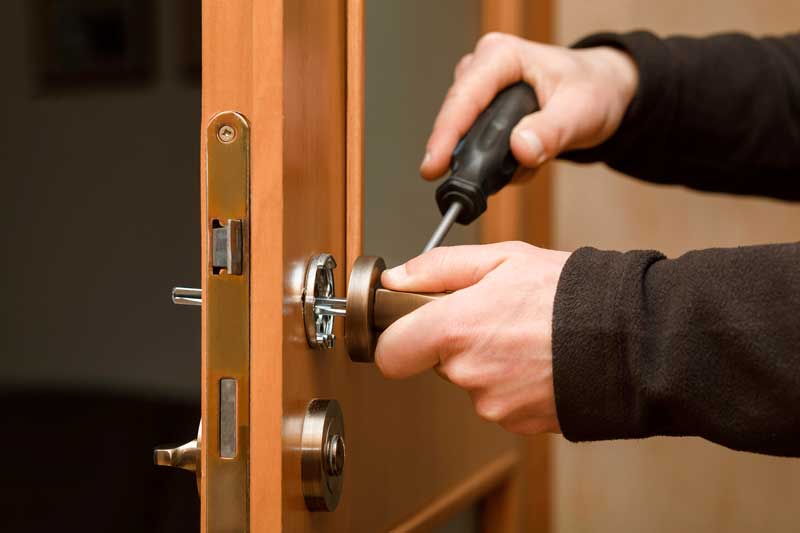
Check and adjust your door hardware to ensure there are no gaps.
Frosty Doors and Hardware
Similar to the seal on a door threshold or frame, a door’s hardware needs to be sealed as well. Remember that hardware is filling a hole in the door that can become loose. Evidence of this gap in the door will be hardware that is cold, wet or even icy/frosty. Considering the heavy usage on door hardware, especially on an active door, loose hardware is usually the culprit.
Check to see that your hardware is centered over the doorknob hole first. Then when the hole is completely covered by the hardware, tighten all the screws on the doorknob or handle. This should alleviate the problem.
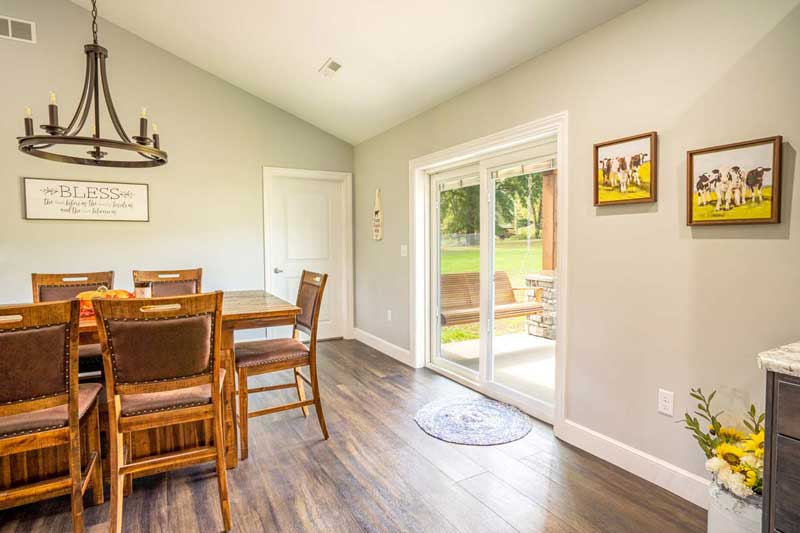
Check the seals and hardware on patio and sliding doors.
Frosty Patio or French Doors
Both sliding patio doors and French doors in a home are subject to developing frost on the inside of the door for a few reasons. First, the humidity inside the home can cause frost to develop on the glass inside the house. But when the frost is developing on just the glass doors and not any windows in the house, gaps in the door may be to blame, not the inside humidity of the house.
To check for drafts on patio doors, ensure that the seal is intact by closing and locking the doors. The hardware on the active sliding door needs to be sealed and tightened as well. The older your patio door, the draftier it can become due to normal wear and tear.
With French doors, one side is the “active door” and the other side is the “passive door”. The active door has the lock hardware and should be sealed tight. The passive door is more problematic, especially if the top and bottom slide bolts that keep it in place are not properly locked. With heavy use, all of this hardware on both the active and passive doors can become loose and out of position, thereby creating gaps letting cold air in the home.
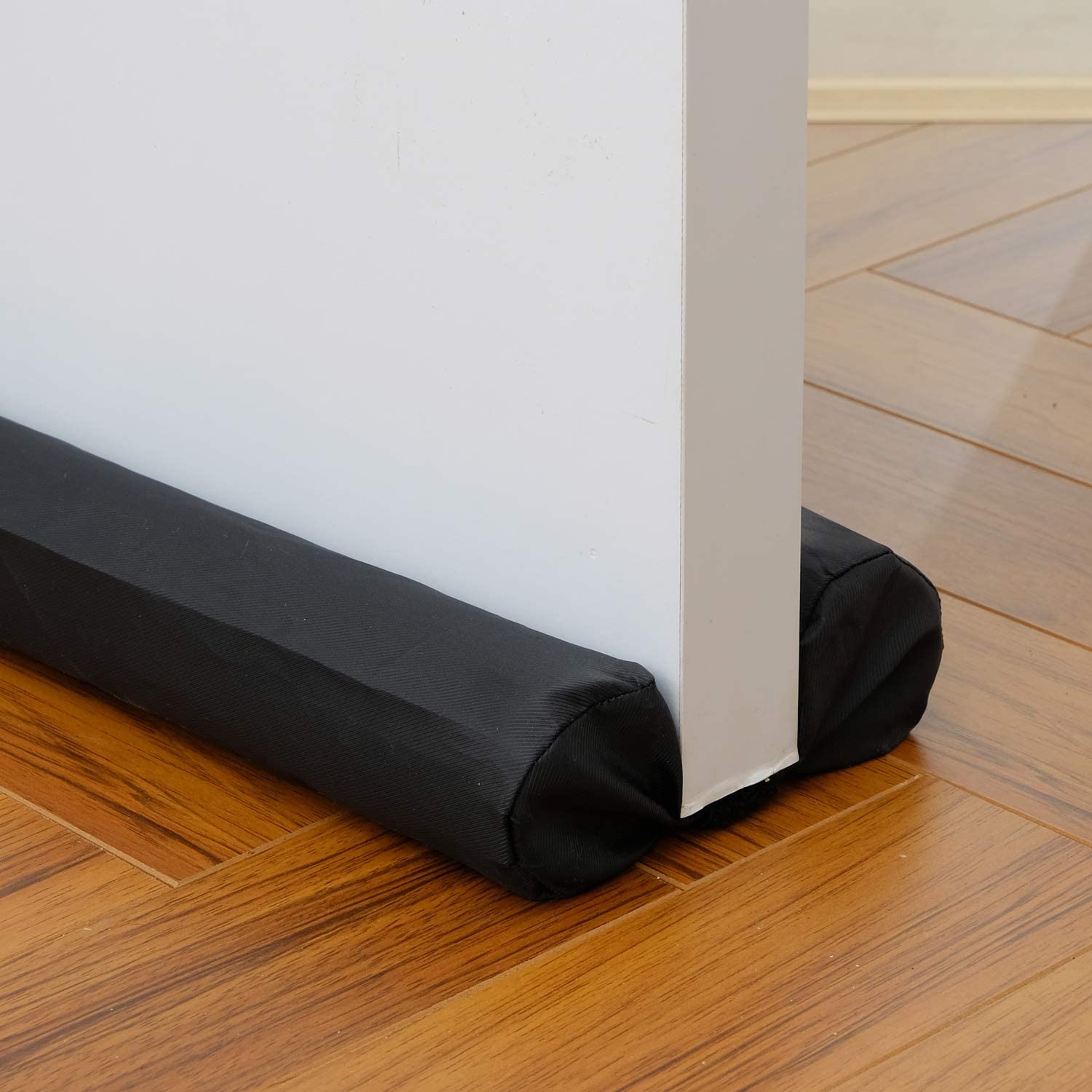
Door Draft Stoppers are simple but effective solutions.
But, It’s a Rental
So your door is a little drafty, but your residence is a rental and you do not want to make any permanent changes. A quick and easy solution to a drafty door is the very cost-effective Door Draft Stopper. Placing this at the bottom of your door is literally a draft stopper. These come in many shapes and sizes to fit your door. Click here for a helpful list of the best sellers on Amazon. If you are really wanting to be budget conscious, simply roll up a bath towel and place it at the bottom of the door.
This Is Not My Forever Home
It may be difficult to justify the cost of a new door for anything other than your forever home. However, door problems do not get better on their own and plans for moving can get delayed months, even years, leaving you uncomfortable in your home. A good door is a sound investment and has a significant Return on Investment; over 70% of the cost can be recovered during the sale of your home. So, go ahead and replace that drafty old door and live in comfort and security while you are thinking about moving. Just think, a potential home buyer will take notice and appreciate the beauty of your front door, and the obvious care you have given to maintain your home.
Drafty doors, just like drafty windows, can substantially impact the inside temperature of your home as well as your utility bill. These solutions to common door problems during the winter season can positively impact the comfort in your home with just a few simple steps.
Proudly serving the Window & Door needs of the Louisville Community!
502-822-5424
4625 Shelbyville Rd
Louisville, KY 40207
Monday thru Friday: 9am – 5pm
Saturday: 9am – 2pm
Sunday: Closed
After Hours by Appointment
 Kentuckiana is our community! We’re locally-owned and operated, not a franchise, so you get attentive, local service.
Kentuckiana is our community! We’re locally-owned and operated, not a franchise, so you get attentive, local service.



Submit the form below and one of our window specialists will be in touch.
